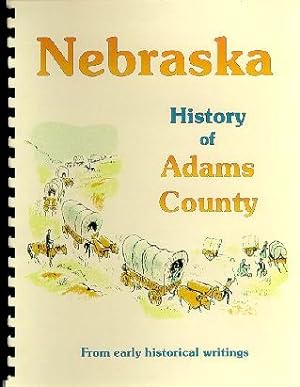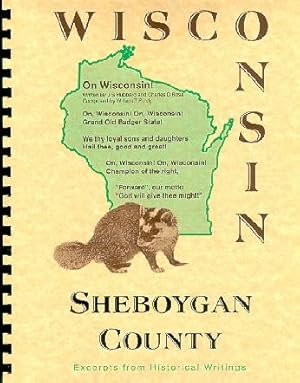Harry L Coles Org (6 results)
Product Type
- All Product Types
- Books (6)
- Magazines & Periodicals
- Comics
- Sheet Music
- Art, Prints & Posters
- Photographs
- Maps
-
Manuscripts &
Paper Collectibles
Condition
Binding
Collectible Attributes
- First Edition (1)
- Signed
- Dust Jacket
- Seller-Supplied Images (4)
- Not Printed On Demand (4)
Seller Location
Seller Rating
-
History of Adams County Nebraska / History of the State of Nebraska
Published by Western Historical Publishing Co., Chicago Illinois, 1882
Seller: A Plus Printing, Tucson, AZ, U.S.A.
Book
Spiral/Comb. Condition: New. No Jacket. Limited Edition Reprint. Early days in Adams County, Nebraska, including the City of Hastings, are recalled in this New 50-page spiral bound booklet excerpted from the rare 1882 book: History of the State of Nebraska, originally published by the Western Historical Co. of Chicago, and Nebraska, a Guide to the Cornhusker State, a 1939 project of the Federal Writers of the Works Progress Administration. A vinyl sheet has been added to protect the full-color front cover. Some of the places mentioned in the booklet include: Hastings (county seat), Inland, Juniata, Ayr, Kenesaw, Millington, Ludlow, Hazel Dell, Mayflower, Kingston, Morseville and Rosedale. Among the many subjects included are: physical features of the county, such as the Little Blue River; early settlers, such as Mortimer Kress, known as Wild Bill, and Jerome Fouts, better known as California Joe; Indian troubles; Organization of the county with the names of early officials; two instances of homicide; First death in the county and other firsts; Railroads; Manufacturers, newspapers, and Banks; Spirited competition over the location of the county seat; County poor farm; Grasshoppers; Agricultural society and other societies, often with names of officers; Farmers Alliance; Public Schools and Churches; Fire Department and Telephone Exchange; and other items of interest. The booklet contains biographies of many prominent residents. While primarily of interest to descendants, these often contain clues to the area and the times. Biographical sketches are given for: Hastings -- John M. Abbott, Samuel Alexander, John J. Anstrom, R.D. Babcock, John F. Ballinger, Silas M. Bates, Robert A. Batty, Fred. J. Benedict, A.W. Binderup, M. Birney, Fred H. Blake, Harry Brooks Borley, Burdick Hutton, Ambrose S. Campbell, Charles Cameron, Samuel Chancy, Benjamin Clark, Delavan S. Cole, George Crane, George W. Dade, Jesse H. Darnell, Lafayette Dominy, Jacob Fisher, Joseph N. Fountain, T.M. Foulks, Peter Fowlie, M.W. Freeman, Frank M. Frink, J.E. Gant, Rev. John W. Greenwood, L.J. Halsted, J.W. Harris, Levi P. Hawley, James B. Heartwell, Rev. S.H. Henderson, David H. Holmes, Hiram E. Houghtaling, F.P. Hoyt, O.C. Hubbell, William Hudson, Jacob Huf, George T. Hutchinson, John G. Iddiols, A.B. Ideson, John C. Ideson, John Jackson, Svend Johnson, Bartholomew Kernan, James Laird, Herman Lepin, Miles K. Lewis, Davis Lowman, W.H. Lynn, James W. Marquis, Robert McClellan, William R. McCully, David M. McElhinney, Miss Lucy A. McFadden, M.M. McGrew, Rev. John H. Mize, John G. Moore, R.R. Morledge, Edwin N. Noyes, Isaac M. Norton, Oswald Oliver, F.L. Pade, L.B. Palmer, C.H. Paul, Frank Phillips, Gustavus D. Pierce, John Plank, George H. Pratt, Richard Rainforth, John J. Haymaker, C.B. Riggs, Charles C. Rittenhouse, L.A. Royce, James K. Sample, Joseph Scales, Joseph R. Sims, James Simeon, Henry W. Skinner, Benjamin F. Smith, Dr. Adams H. Sowers, C.B. Sperry, Rev. Jeremiah D. Stewart, N.V. Stine, Horace C. Thatcher, Jacob Thomas, L.H. Tower, Robert B. Tussey, J.H. Van DeMark, Myron Vanfleet, Andrew Veith, N. B. Vineyard, James Walling, S.J. Weigel, Martin F. Wallace, Jacob Wooster, John J. Wemple, George F. Wilkin, Alfred Woolman, and Abraham Yeazel; Juniata -- Winfield Ackley, John E. Adams, E.M. Allen, Peter Anderson, Robert Ash, Anson S. Austin, A.H. Brown, Judson Burwell, Spencer W. Clark, Albert V. Cole, William B. Cushing, Ira G. Dillon, David H. Freeman, M.K. Hutchinson, William L. Kilburn, Columbus A. Lane, J.W. Liveringhouse, Wilson D. Murray, James Newell, Lorenzo F. Picard, Samuel J. Shirley, Gurdon G. Sill, Jacob Swift, Le Grand B. Thorne, Frank E. Wilson, George Walker, and George Watkins; Ayr -- Samuel A. Bookwalter, James E. Bovard, Eli M. Burton, A. True Dyer, Gordon H. Edgerton, Thomas Edgington, Melville B. Foote, Albert N. Hall, Christian Koehler, W.W. Phar, James Ritcheson, Oliver C. Rogers, James S. Way, M. Weinberg, and A.L. West; Kenesaw -- H.D. Einsparr and John G.
-
History of Northern Wisconsin / Sheboygan County Wisconsin History
Publication Date: 1881
Seller: A Plus Printing, Tucson, AZ, U.S.A.
Book
Spiral/Comb. Condition: New. No Jacket. Limited Edition Reprint. Early days in Sheboygan County, WI, are recalled through a mixture of colorful tales, historic data and individual biographies in this NEW 57 page 8 1/2" x 11" spiral-bound booklet. The front cover is a parchtex card stock, protected with a vinyl sheet. The information comes from a rare 1881 book, entitled History of Northern Wisconsin. We've enlarged the area on a map from the original book. Communities currently listed for this area by the National Association of Counties include: Adell, Cascade, Cedar Grove, Elkhart Lake, Glenbeulah, Greenbush, Haven, Herman, Hingham, Holland, Howards Grove, Kohler, Lima, Lyndon, Mitchell, Mosel, Oostburg, Plymouth, Random Lake, Rhine, Russell, Scott, Sheboygan (County Seat), Sheboygan Falls, Sherman, Waldo, Wilson. (Some towns may not be mentioned in the booklet.) Among the many subjects included are: Location and Natural Resources; Prehistoric Remains; the meaning of Sheboygan; Early Visitors and names of first settlers; Organization of the county and officers in 1881; Harbor Improvements; Transportation and Communication, including Railroads; Postal Facilities; Names of those elected to the state legislature, 1848-1881; Schools; Agricultural growth; the Civil War Period, with names of some officers, and the "Indian scare"; Tornado of 1873; the City of Sheboygan, including a nice sketch; early city officials; an artesian well; fire departmen;, banks; Sheboygan Merchants' Association; Churches; Societies; Newspapers; Library Association; Fishing and Marine Interests; Manufacturing and Business Interests; Sheboygan Falls, with a list of 1840 citizens, and 1854 village officials; the town of Plymouth and its early residents; and to a lesser extent, the villages of Greenbush, Glenbeulah, Mosel, Herman, Howard's Grove, Franklin, Rhine, Russell, Lima, Holland, Cedar Grove, Oostburg, Amsterdam, Wilson, Lyndon, Cascade, Waldo, Onion River, Winooski, Sherman, Random Lake, Sherman Station, Silver Creek, Mitchell, and Scott. Attention Genealogists: This booklet contains biographies of many county residents of the late 1800s. Some of these are brief, but others include family members, affiliations, war records, and business activities, in the course of which they often shed light on area businesses, churches, professions and institutions, and on news events: Sheboygan -- Chrisian Ackermann, George Allen, William Ashby, Harry A. Barrett, James Bell, William E. Bendler, John Bertschy, August Bentrop, Thomas M. Blackstock, Louis Bode, William Brechtel, George W. Bradford, Herman Buchheim, William H. Burk, Nathan Cole, Charles A. Dean, Paul Diehl, John N. Elliott, Ole M. Ellison, Alpheus E. Elvin, William Elwell, Joseph End, George End, E.P. Ewer, Evan Evans, Albert Fairchild, Peter Feagan, Reinhard B. Firzlaff, Henry J. Fischer, John Flaig, Capt. John M. Folger, Henry Foeste, George M. Gearlds, Frank Geele, Rev. John G. Goehringer, E.B. Garton, John Griffith, Bernard R. Grogan, George M. Groh, Oley Groh, William Grube, Theodore Gunther, Henry Guenther, Henry Gutsch, Adolph F. Gutsch, William Halbach, Charles H. Halbach, DeWisner Galsted, L.D. Harvey, Christian Heyer, Andrew Higby, John Hickey, Frederick Hildebrand, Jacob Hilpertshauser, Dr. Frederick Hahn, Jacob Imeg, David Jenkins, Peter Johnson, Fr. Karste, John G. Kern, Joseph F. Kent, Jacob Kemph, August Keseweter, Norris W. Kilton, Joseph Kellner, Louis A. Keppler, Frederick Koehn, John M. Kohler, John Kroeff, Gen. Conrad Krez, James Lampman, Francis Lawrence, John Laing, Emil Lieberman, Dr. Adolph F. St. Sure Lindsfelt, August Loesing, Charles Lutze, Worthy McKillip, Gustavus Mallmann, August Mallmann, Anton J. Mallmann, William Mallmann, George B. Mattoon, Earnest Marshall, James H. Mead, Herman Mehrtens, Phillip Meyer, John W. Morgeneier, John Mogensen, Fred D.D. Mueller, Carl Muth, Henry Muth, Jacob P. Nytes, Arthur O'Neil, Charles Oehler, George Olson, Frederick Pape, C. Henry Pape, John H. Plath, W.
-
History of the Upper Peninsula of Michigan / History of Houghton County Michigan
Published by Western Historical Publishing Co., Chicago Illinois, 1883
Seller: A Plus Printing, Tucson, AZ, U.S.A.
Book
Spiral/Comb. Condition: New. No Jacket. Limited Edition Reprint. Early days in Houghton County, MI, are recalled in this new 79-page booklet titled: Houghton County, Michigan, USA The spiral-bound booklet includes excerpts from two hard to find sources: the 1883 History of the Upper Peninsula of Michigan and Michigan, a Guide to the Wolverine State, a 1941 product of the WPA Writer's Program. The tri-color cover is printed on 80# card stock and protected with a vinyl sheet. The text is printed on 8.5" x 11" opaque paper. Among the subjects included are: Physical features; Organization of the County; Township Organizations; County Institutions; Population; Military; Road and Waterways; Agriculture; Mines and Mining Companies (extensive); the villages of Houghton and Hancock (with illustrations of each), Churches; the Portage Lake Mining Gazette; Societies; Post Office; Hotels; Historical Society and Mining Institute; Commercial Interests and Manufacturing Enterprises; Calumet and Red Jacket (with illustration); Lake Linden (with illustration) etc. In addition to the many names mentioned throughout the booklet, there are a number of biographies. These often shed light on area businesses, churches, professions and institutions, and on the events of the day. The names, arranged by towns, include: Houghton -- Joseph A. Ames, Harry S. Beesley, James H. Blandy, Rev. James Langhorne Boxer, William W. Butterfield, Thomas L. Chadbourne, Walter Chubb, Stephen E. Cleaves, William S. Cleaves, Proctor P. Cowles, Joseph Croze, William Cullyford, August Dallmeyer, John Davies, Columbus C. Douglas, Edward F. Douglass, Frank A. Douglass, Capt. W.A. Dunn, James P. Edwards, Joseph P. Edwards, Capt. Richard Edwards (with 2 pix), Thomas W. Edwards (pix), Charles F. Eschweiler, H. Goldberg, Rufus R. Goodell, P.R. Gottstein, Claudius Buchanan Grant, Adam Haas, David Haas, Joseph Haas, Charles Hafenreffer, Franz Hahn, William Harris, James Healy, George S. Hebert, Robert S. Hill, William Hitchings, Capt. John Hoar (pix), Richard M. Hoar, William B. Hoar, Harry S. Hodge, Capt. John C. Hodgson, Jay Abel Hubbell (2 pix), Rees James, Kehl Brothers (William, Herman and Charles), Fred W. Kroll, William Lean, G. Leibetrau, Ernst Leibetrau, Benjamin R. Livermore, Dr. John S. Livermore, Samuel McDonald, William Miller, Edward R. Penberthy, James Pryor, Frank Pumerville, Joseph W.V. Rawlins, Carlos D. Shelden, George Shelden, Ransom B. Shelden, Ransom Shelden (2 pix), Edward L. Siller, Patrick Slattery, J.B. Sturgis, J.C. Thomson, Capt. Richard Uren, M.Van Orden; Hancock -- Jacob Baer, Max Baer, Frederick J. Bawden, James Bawden, O.D. Bentley, Brown and Mette (wagon makers), Morton L. Cardell, William H. Carr, James A. Close, William Condon, D.B. Cooper, Dennis Coughlin, D. Crawford, Patrick Cuddihy, Gustave Deimel, James Dennis, Michael Doyle, Henry Dritler, Houghton Duncan, Ernest Fisher, Frederick W. Gettling, Dr. Patrick Henry Gallagher, Capt. John Gundry, John Gundry, J.E. Hocking, Peter Holman, Thomas Ingram, Rev. Edward Jacker, Hugh Johnson, David S. Kendall, E.P. Kibbee, William Lapp, Charles Leiblein, William H. Mason, Charles. S. Mawrey, Thomas D. Meads, Charles H. Miller, Mathew M. Moralee, Dr. A. Overfield, Samuel P. Payne, W.H. Roberts, Orin W. Robinson, S.S. Robinson, Capt. James Rass, Adolph Ruhl, Peter Ruppe, Edward Ryan, Capt. John C. Ryan, Archibald J. Scott, Frank Scott, T.J. Shellhorn, Thomas Smart, Capt. Joseph Snell, Charles A. Stringer, E.S. Sturtevant, Mrs. Sarah Thomas, John Thomas, Dr. Henry Tidemann, E. H. Towar, A.H. Trowbridge, Fred Voss, Dr. Charles H. Walker, Rev. Phillip Wambsganss Jr., Joseph Wertin, Rev. Frank N. White, Benjamin Wieder, Charles A. Wright, Edward L. Wright, Z.W. Wright; Calumet -- Charles Briggs, Elbridge G. Brown, Capt. John Cameron, Rev. John Chebul, William A. Childs, Hiram K. Cole, H.S. Colton, James N. Cox, Edwin T. Curtis, Capt. William Daniell, John A. Danielson, John Duncan, J.L. Gardner, James Grierson, Capt. Thomas Hoatson, Capt. J.D. Hoskins, Dr. Henry Isler, S.
-
TOTAL WAR AND COLD WAR : Problems in Civilian Control of the Military
Published by Ohio State Univ Press, Columbus, OH, 1962
Seller: 100POCKETS, Berkeley, CA, U.S.A.
Book First Edition
Hardcover. Condition: Near Fine. No Jacket. First Edition, First Thus. EX-LIB/UNCIRCULATED Copy. Text/BRAND NEW & Bright. Red linen boards/NF. A Mershon National Security Center publication. Classic, historical pPapers presented Feb 27th/28th, 1959, at the conference on civil-military relations held at Ohio State Univ. 300 pgs, essays arranged in 3 parts:. I, The High Command in World War II (6 papers); II, Organizational & Political Relationships in American Government (4 papers); and III, Generals & Party Leaders in Communist States (2 papers).
-
Civil Affairs : Soldiers Become Governors (Book One)
Published by University Press Of The Pacific, 2005
ISBN 10: 1410222039ISBN 13: 9781410222039
Seller: AHA-BUCH GmbH, Einbeck, Germany
Book Print on Demand
Taschenbuch. Condition: Neu. nach der Bestellung gedruckt Neuware - Printed after ordering - As a documentary history, this volume illustrates the evolution of civil affairs policy and practice in the Mediterranean and European Theaters of Operations during World War II. It deal s with U.S. Army and Anglo-American planning and operations in the sphere of relations with civilians in certain liberated and conquered countries in Europe during the war, prior to the invasion of Germany. Although the Army had not considered civil affairs preparation essential prior to World War II, during the war it created the Civil Affairs Division at the War Department level to coordinate all civil affairs planning and training. For the first time, extensive recruiting and training programs were organized, and G-5 (civil affairs and military government) staff sections were added at the theater army, corps, and division levels.Not only did soldiers become the administrators of civilian life for the Army's immediate needs, they also became the executors, and sometimes the proposers, of national and international political policy. This broader role was the result of the inability of the Allies to agree on specific political aims until after active hostilities were over, if then. In this policy void, U.S. and British military authorities were often responsible for the gradual transition to a postwar national and international order with only general guidelines from higher authorities.The materials presented in Part I, concerned with the preparatory and organizational stage, suggest that the President's decision to entrust the civil affairs responsibility to the Army was because civilian authorities were unready to undertake the mission. Documents in Part II show the difficulties of fitting civilian institutions into the context of battle and a military framework, thus indicating additional rationale for leaving military authorities in exclusive control. Part III reveals that, despite this experience, Allied authorities planning for the liberated countries of northwest Europe still proposed to delegate civil affairs to indigenous civilian authorities, insofar as was possible. Operations are dealt with in Part IV, which show that conditions during and immediately following hostilities made it necessary for the Allies to render these authorities substantial assistance in the area of civil affairs. The compilation of documents appear to make it clear that the issue of military-versus-civilian administration was far less important than the issue of military values versus civil-political values, and it was in the latter area that the most serious difficulties arose.KEY TOPICS:1. Arguments over civilian or military control of civil affairs (Ch. I)2. Civilian civil affairs activities in French North Africa and gradual military involvement (Ch. II)3. Creation of a military organization to undertake civil affairs activities (Chs. III-VI)4. Military government/civil affairs operations in Italy (Chs. VII-XXI)5. Planning for civil affairs operations in Europe (Chs. XXII-XXIV)6. Military government/civil affairs operations in western Europe (Chs. XXV-XXXII).
-
Civil Affairs : Soldiers Become Governors (Book Two)
Published by University Press Of The Pacific, 2005
ISBN 10: 1410222047ISBN 13: 9781410222046
Seller: AHA-BUCH GmbH, Einbeck, Germany
Book Print on Demand
Taschenbuch. Condition: Neu. nach der Bestellung gedruckt Neuware - Printed after ordering - As a documentary history, this volume illustrates the evolution of civil affairs policy and practice in the Mediterranean and European Theaters of Operations during World War II. It deal s with U.S. Army and Anglo-American planning and operations in the sphere of relations with civilians in certain liberated and conquered countries in Europe during the war, prior to the invasion of Germany. Although the Army had not considered civil affairs preparation essential prior to World War II, during the war it created the Civil Affairs Division at the War Department level to coordinate all civil affairs planning and training. For the first time, extensive recruiting and training programs were organized, and G-5 (civil affairs and military government) staff sections were added at the theater army, corps, and division levels.Not only did soldiers become the administrators of civilian life for the Army's immediate needs, they also became the executors, and sometimes the proposers, of national and international political policy. This broader role was the result of the inability of the Allies to agree on specific political aims until after active hostilities were over, if then. In this policy void, U.S. and British military authorities were often responsible for the gradual transition to a postwar national and international order with only general guidelines from higher authorities.The materials presented in Part I, concerned with the preparatory and organizational stage, suggest that the President's decision to entrust the civil affairs responsibility to the Army was because civilian authorities were unready to undertake the mission. Documents in Part II show the difficulties of fitting civilian institutions into the context of battle and a military framework, thus indicating additional rationale for leaving military authorities in exclusive control. Part III reveals that, despite this experience, Allied authorities planning for the liberated countries of northwest Europe still proposed to delegate civil affairs to indigenous civilian authorities, insofar as was possible. Operations are dealt with in Part IV, which show that conditions during and immediately following hostilities made it necessary for the Allies to render these authorities substantial assistance in the area of civil affairs. The compilation of documents appear to make it clear that the issue of military-versus-civilian administration was far less important than the issue of military values versus civil-political values, and it was in the latter area that the most serious difficulties arose.KEY TOPICS:1. Arguments over civilian or military control of civil affairs (Ch. I)2. Civilian civil affairs activities in French North Africa and gradual military involvement (Ch. II)3. Creation of a military organization to undertake civil affairs activities (Chs. III-VI)4. Military government/civil affairs operations in Italy (Chs. VII-XXI)5. Planning for civil affairs operations in Europe (Chs. XXII-XXIV)6. Military government/civil affairs operations in western Europe (Chs. XXV-XXXII).






